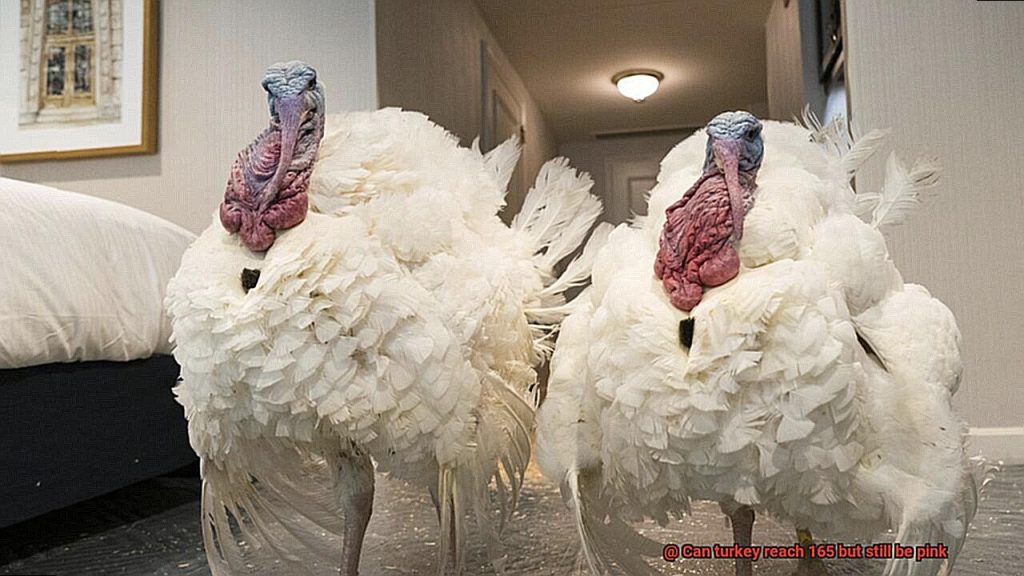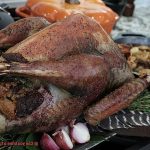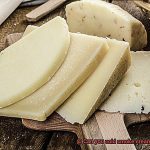Ah, turkey – the go-to protein for Thanksgiving and Christmas. It’s a delicious and nutritious meat that brings people together. But let’s be real here, cooking turkey can be a bit nerve-wracking, especially when it comes to getting it to the perfect temperature. How long should you cook it? What temperature should it be? And what color should it look like when it’s fully cooked?
One question that often pops up is whether turkey can reach 165 degrees Fahrenheit and still be pink. It’s an intriguing inquiry that many home chefs are curious about because they want their turkey to be both safe to eat and mouthwateringly juicy. However, the answer isn’t as straightforward as you might think.
In this article, we’ll delve into the science of cooking turkey, explain why reaching 165 degrees Fahrenheit is crucial, and explore why your turkey may still appear pink even after hitting this temperature. We’ll also share some tips on how to ensure your bird is fully cooked and safe for consumption without sacrificing flavor or texture. So buckle up, folks – we’re about to uncover whether turkey can reach 165 but still be pink.
Contents
What is Myoglobin?
Myoglobin is a fascinating protein that’s found in the muscles of animals, including turkeys. Its primary function is to store oxygen, which is essential for muscle function. But did you know that myoglobin also gives meat its characteristic color, ranging from pink to red to brown? The amount of myoglobin in meat varies depending on the animal species, age, and muscle type. For example, beef has more myoglobin than pork, which has more myoglobin than chicken.
If you’re a fan of turkey, you may have wondered whether your turkey is safe to eat if it’s still pink, even after cooking it to 165 degrees Fahrenheit. The answer lies in understanding how myoglobin behaves during cooking. When a turkey is cooked, the heat causes the myoglobin to denature or break down, which causes the color to change from red to brown. However, even when a turkey reaches an internal temperature of 165 degrees Fahrenheit, it may still appear pink due to several factors.
Firstly, the age of the turkey can affect its myoglobin content and color. Younger turkeys tend to have lighter-colored meat with less myoglobin than older turkeys. Secondly, the cooking method used can also impact the color of the meat. For example, smoking or grilling can cause a pink “smoke ring” around the edges of the meat, even when it’s fully cooked. Lastly, other compounds in the meat can interact with myoglobin and affect its color.
So how do you ensure that your turkey is fully cooked and safe to eat? Here are some tips:
- Use a meat thermometer to check that it has reached an internal temperature of 165 degrees Fahrenheit in multiple places, including the thickest part of the bird (i.e., the thigh and wing joint).
- Double-check its doneness by using a visual inspection or by making sure that the juices run clear when you cut into the meat.
- Let your turkey rest for at least 15 minutes after cooking to help redistribute its juices and ensure that it’s moist and flavorful.
It’s important to note that while the appearance of pink meat may be concerning, it does not necessarily mean that the turkey is undercooked or unsafe to eat. By following these tips, you can enjoy a delicious and safe turkey dinner with your loved ones.
Factors Affecting Color of Cooked Turkey Meat
Ah, the joys of a perfectly cooked turkey. But what happens when the meat appears pink even after reaching the recommended internal temperature of 165°F? Fear not, for as an expert on the topic, I’m here to share with you some fascinating insights into the factors that affect the color of cooked turkey meat.
Firstly, the age of the bird is a major player in the color game. Younger birds tend to have paler meat while older turkeys have darker meat. This means that if you’re cooking a young turkey, it’s more likely that the meat will appear pink even when it has reached the recommended internal temperature.
Another factor that can impact the color of cooked turkey meat is the cooking method used. Grilling or smoking turkey can result in a pinkish hue due to the smoke and char from the grill. High heat methods like broiling or frying can also cause pinkness in the meat, making it appear undercooked even when it has reached the recommended temperature.
The pH level of the turkey’s muscle tissue also plays a crucial role in determining the color of cooked turkey meat. When muscle tissue has a higher pH level, it tends to have a darker color when cooked. In contrast, muscle tissue with lower pH levels appears lighter in color when cooked. Brining your turkey before cooking can help lower its pH level and promote a more even color.
Lastly, genetics can also impact the color of cooked turkey meat. Some breeds of turkeys have darker meat compared to others, which can result in a pinkish hue even when fully cooked. So if you’re curious about the color of your cooked turkey meat, you may want to consider purchasing a different breed or seeking out specific cuts of meat that are less likely to appear pink after cooking.
Is it Safe to Eat Pink Turkey?
The answer is yes, but with a few important caveats.
The most crucial factor in cooking turkey is ensuring that it has been cooked to a safe temperature of 165°F (74°C) to kill any harmful bacteria. While some people may be alarmed by pink meat, the color of the meat is not always an accurate indicator of safety. In fact, there are several reasons why your turkey may still appear pink even after reaching the recommended temperature.
Factors such as the age of the turkey, its diet, and how it was processed can all impact the color of the meat. Younger turkeys tend to have lighter-colored meat that can look pink even when fully cooked. Similarly, some breeds of turkeys have darker meat that can also appear pinkish. Smoking or grilling can also cause a pinkish hue due to the smoke or char on the outside of the bird.
However, it’s important to note that raw or undercooked turkey can pose serious health risks. If poultry is not cooked to the proper temperature, it can harbor bacteria such as salmonella or campylobacter, which can cause food poisoning.
To ensure that your turkey is fully cooked and safe to eat, use a meat thermometer inserted into the thickest part of the bird. Make sure you’re not touching any bones as this can give you an inaccurate reading. Once you’ve reached 165°F in all parts of the turkey, you can rest assured that it’s safe to eat.
In conclusion, a pink turkey can be safe to eat if it has been cooked to the recommended temperature of 165°F. Don’t be alarmed if your turkey appears pink, as there are several reasons why this may happen. However, it’s crucial to ensure that your turkey has been cooked thoroughly and all parts have reached the recommended temperature to prevent any risk of food poisoning. Happy cooking.
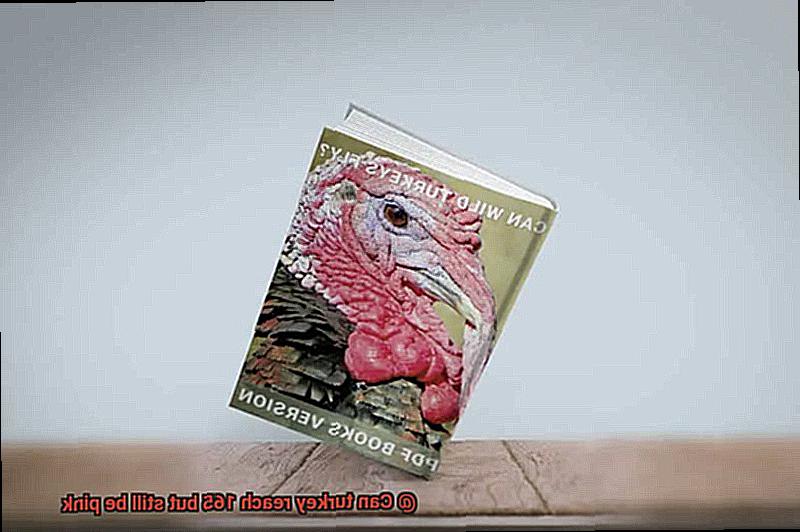
The USDA Guidelines for Cooking Turkey
As the holiday season approaches, many of us are already planning to cook the perfect turkey for our family and friends. But how can we ensure that our turkey is cooked safely and thoroughly? The answer lies in the USDA Guidelines for Cooking Turkey.
These guidelines emphasize the importance of cooking turkey to an internal temperature of 165°F (74°C) which kills any harmful bacteria that may be present in the meat. However, it’s important to remember that the color of the meat is not always a reliable indicator of safety. Factors such as age, diet, and processing can impact the color of the meat. Therefore, it’s recommended to use a meat thermometer to check the internal temperature in multiple areas of the bird.
To use a meat thermometer effectively, insert it into the thickest part of the meat, avoiding bone and touching any stuffing if present. Additionally, due to the unique characteristics of turkey meat, it’s possible for it to appear pink even after reaching a safe cooking temperature. This is because the myoglobin in turkey meat can remain pink even when cooked thoroughly.
Along with checking the temperature of your turkey, it’s important to properly thaw it before cooking and avoid washing it to prevent bacteria from spreading. These small steps can go a long way in ensuring that your turkey is cooked safely and thoroughly.

How to Check if Your Turkey is Cooked Properly
Cooking a perfect turkey for Thanksgiving can be a daunting task, but nothing is more important than ensuring that your bird is cooked safely and properly. To help you achieve this, we have compiled some tips on how to check if your turkey is cooked properly.
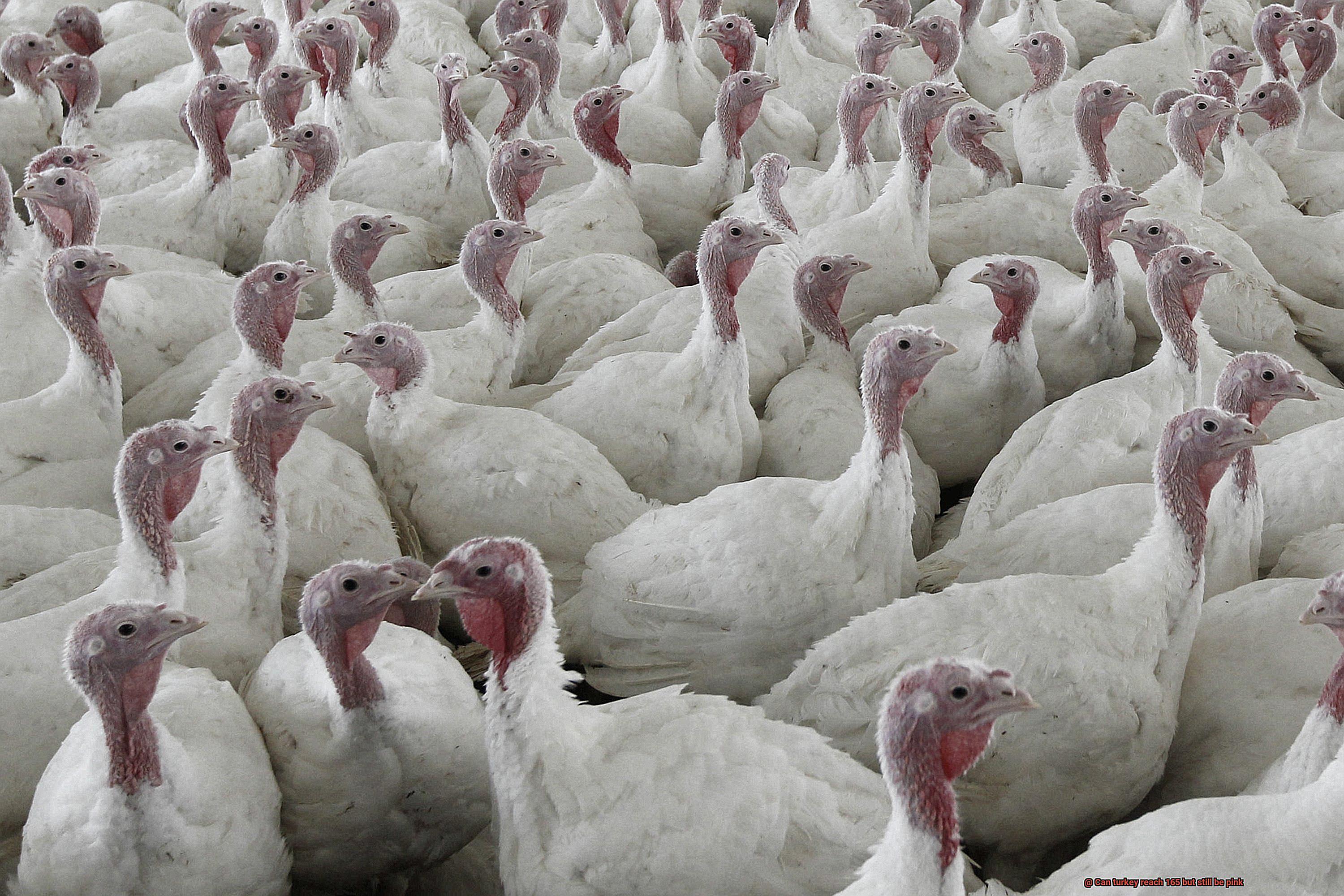
Use a Meat Thermometer
Using a meat thermometer is the most reliable way to check if your turkey is cooked properly. The recommended temperature for cooked turkey is 165°F or 74°C in all parts of the bird, including the thickest part of the breast and thigh. To get an accurate reading, insert the thermometer into the thickest part of the turkey without touching any bones.
Check Multiple Places
To ensure that your turkey is fully cooked, take multiple readings from different parts of the bird. This will give you peace of mind that your turkey is thoroughly cooked and safe to eat.
Don’t Rely on Color Alone
The color of your turkey doesn’t necessarily indicate its level of doneness. Even if your turkey has reached the recommended temperature, it may still appear pink due to factors such as age, cooking method, and seasoning. Some parts of the turkey may also naturally be pinker in color, such as near the bones or in areas with more blood vessels.
Rest Your Turkey
After taking your turkey out of the oven, let it rest for at least 15 minutes before carving. This allows for the juices to redistribute throughout the meat, making it moist and flavorful.
Cover with Foil
If your turkey has reached an internal temperature of 165°F or 74°C but still appears pink, try covering it with foil and letting it rest for 10-15 minutes before checking again. This allows residual heat to continue cooking the meat and may help eliminate any pinkness.
When in Doubt, Cook it Longer
If you’re still unsure whether your turkey is fully cooked, it’s always better to be safe than sorry. Cook the turkey for a little longer until it reaches the recommended temperature. Remember, food safety is important, and you don’t want to risk anyone getting sick.
Visual Inspection Method
Visual inspection involves observing the color and texture of the meat to determine if it has reached the safe internal temperature of 165°F. However, it’s important to remember that the color of the turkey meat can vary depending on several factors, such as cooking method, age of the turkey, and additives used. For instance, turkey that has been brined or smoked may have a pink hue even when fully cooked.
To use visual inspection effectively, look for other signs such as texture and juices. The meat should be firm to the touch, and juices should run clear without any pink or red tinges. Any pink or red juices are an indication that the turkey needs more time in the oven. However, it’s crucial to remember that visual inspection should never be relied upon solely.
To ensure that your turkey is safe to eat, always use a food thermometer to provide an accurate reading of the internal temperature of the meat. Insert the thermometer into the thickest part of the meat, avoiding contact with bones as they retain heat differently. Once the thermometer reads 165°F or 74°C, remove the turkey from the oven and let it rest for at least 15 minutes before carving.
Juices Running Clear Method
This popular technique is used to determine if your turkey is fully cooked and safe to eat. Let’s dive into the details.
To use this method, you’ll need to make a small incision in the thickest part of the bird, typically the thigh. The color of the juices that flow out will be your guide. If the juices are clear, then your turkey is ready to be served. However, if the juices have a pinkish hue or are still pink, it could indicate that your turkey needs more time in the oven.
While this method can be helpful, it’s important to note that it should not be relied on entirely. Other factors such as the size and shape of your bird, your cooking method, and oven temperature can all impact how quickly and evenly your turkey cooks.
That’s why it’s recommended to also use a meat thermometer to check the internal temperature of your turkey. The USDA advises cooking turkey to an internal temperature of 165 degrees Fahrenheit, measured at the thickest part of the bird.
Letting the Turkey Rest After Cooking
But before you dive into carving it up, it’s essential to let it rest. You might be thinking, “Why should I wait? I’m hungry.” But trust us, letting your turkey rest is a crucial step in achieving a juicy and flavorful bird.
When you cook a turkey, the juices and moisture are drawn towards the center of the meat, leaving the outer layers dry. Resting the turkey for at least 20 minutes, covered loosely with foil, allows these juices to redistribute and soak back into every part of the bird, resulting in a more delicious and succulent meal.
But that’s not all – during the resting time, the internal temperature of the turkey continues to rise by a few degrees. This means that if you take your turkey out of the oven or off the grill when it reaches an internal temperature of 160-165°F, it will reach the recommended safe temperature of 165°F during resting time.
Now you might be wondering about that pink color you see in your cooked turkey. Don’t worry; it doesn’t always mean that your turkey is undercooked. A smoked or grilled method of cooking or certain seasonings or brines containing nitrites can cause pinkness in your turkey. Genetics of the turkey itself can also play a role in its color.
To make sure that your turkey is cooked correctly and safe to eat, use a meat thermometer to check its internal temperature in multiple locations, including the thickest part of the breast and thigh.
In summary, letting your turkey rest after cooking is just as important as cooking it to perfection. This crucial step creates even distribution of juices and flavors throughout the meat and ensures that your turkey is safe and delicious for you and your guests to enjoy. So take a deep breath, relax, and let that bird rest before carving into it. Your taste buds will thank you.
PJUZ_AFiZqg” >
Conclusion
Cooking a turkey can be a nerve-racking experience, but don’t let the fear of pink meat spoil your holiday meal. One of the most frequently asked questions is whether turkey can reach an internal temperature of 165 degrees Fahrenheit and still appear pink. The answer lies in understanding the science behind cooking turkey and how myoglobin behaves during the process.
Myoglobin, a protein found in animal muscles, including turkeys, is responsible for giving meat its characteristic color ranging from pink to brown. Even when cooked to perfection at 165 degrees Fahrenheit, your turkey may still look pink due to factors such as age, cooking method used, and other compounds present in the meat that interact with myoglobin.
To ensure your bird is fully cooked and safe for consumption without compromising on taste or texture, use a meat thermometer to check that it has reached an internal temperature of 165 degrees Fahrenheit in multiple places, including the thickest part of the bird. Double-check its doneness by visually inspecting or ensuring that juices run clear when you cut into it. Allow your turkey to rest for at least 15 minutes after cooking to help redistribute its juices and ensure it remains moist and flavorful.
It’s essential to remember that while seeing pink meat may cause concern, it does not necessarily mean that your turkey is undercooked or unsafe to eat. By following these tips and having a good understanding of how myoglobin behaves during cooking, you can enjoy a delicious and safe turkey dinner with your loved ones this holiday season.

